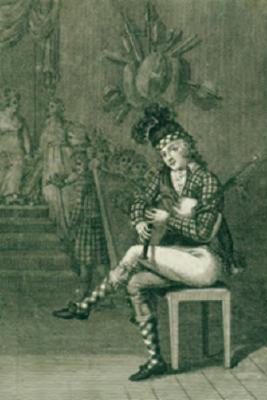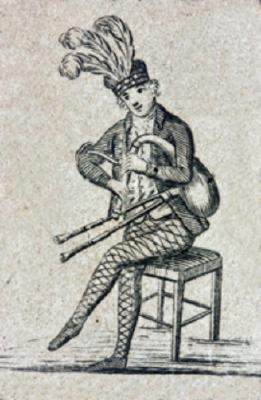The Bagpipe Society
A thought on Pastoral to Union
It is an accepted fact that at some point, probably around 1770-80, players of pastoral pipes gradually removed the bottom joint of their chanters and started playing them on the knee. In this short piece I will explore one possible scenario, one possible driver to that transformation.
Pictorially, there is little evidence. The Irish piper curiously sketched by John Malchair in 1784 (Oxford) shows him playing on the knee. (See image on back cover). The only surviving drawing of Denis Courtney, playing in Oscar and Malvina (c1791) shows a bell ended chanter and the characteristically swan neck to the bag of Pastoral pipes. (See over, left.)

Of O’Farrell (on the right), who replaced Courtney in Oscar and Malvina on the latter’s death, the chanter bottom is the much more familiar shape of a union pipe chanter, and the pipes have a wider bag neck. (c1804). Also note the drone position. Earlier pictures by Sandby all show the long Pastoral type of chanter.

We know that O’Farrell published tunes with low and high nominal “C”, around 1804, suggesting that he was aware of players both using and having abandoned the bottom joint.
But the question of why has never been pinned down. I suggest that it was for pragmatic reasons. Pipes have developed for a need. As an example, when Irish music was popular in the large concert halls of America, the bore dimensions were changed to give a louder instrument. Some folks think that the bottom joint was lost because the instrument was difficult to handle, being so long, but I feel there is a further reason.
I was in an internet discussion on Northumbrian Smallpipe (NSP) page, involving John Dally, which pushed me to re-read “The Interpretation of the of the Music of the XVIIth and XVIIIth Centuries, revealed by contemporary evidence” by Arnold Dolmetsch. Dolmetsch has a lot to say about music, but only mentions bagpipes three times. In two instances he quotes from “Essai d’une Méthode pour aptpendre à jouer de la Flute Traversière, avec plusieurs remarques pour server au bon gout dans la musique” by Jean Joachim Quantz, 1752.
In chapter 10 (p281 in Dolmetsch ); “One must not slur the notes which should be detached, nor detach those which should be slurred. The notes must not seem to be glued together. The tongue must articulate on the wind instrument and the bow on the stringed instrument, always according to the intentions of the composer as indicated by dashes and slurs. The notes will thus obtain all their liveliness, and the expression will be distinguished from the bagpipe, which is played without articulation. However well ordered fingers may be, they cannot alone produce musical speech; the tongue and the bow must help, and it is these latter which affect most the expression of a piece”.
He further quotes “La Tonotechchnie, ou l’Art de Noter les cylindres et tout ce qui est susceptible de Notage dans les instruments de Concerts Méchaniques” , par le Père Engramelle, Reigieux Augustin de la Reine Marguerite. Paris 1775, p18 (p282 in Dolmetsch), “all the notes in execution, whether ornamented or not, are partly in hold and partly in silence; which means that they all have a certain length of sound and a certain length of silence, which united make the whole value of the note. These silences at the end of each note fix its articulation and are as necessary as the holds themselves, without which they could not be detached from one another; and a piece of music, however beautiful, would be no more agreeable without these silences d’articulation than those country songs of Poitou, performed upon the insipid bagpipes which only give a noisy and inarticulate sound”.
He is describing staccato, which became very fashionable c1770.
Dolmetsch continues, “The ‘insipid noisy, and inarticulate’ bagpipe gives pleasure to some; and even the bagpipe style of Bach playing of the present time has admirers”.
Some have said that the removal of the foot joint makes the instrument easier to handle when seated, some have postulated that pipers experimented having heard NSP players. But I wonder if pipers were driven to play on the knee, abandoning the bottom joint, to keep in fashion, and work, by playing with staccato. A pragmatic choice, fashion dictating form and practice. And so the ’tight’ style of Union piping was born.
We will never know for certain, but this could explain the change.
Footnote: Arnold Dolmetsch has a lot to say regarding both tempo and gracing.
He is well worth reading for any musician and his writing can be downloaded free from the Petrucci library.
References:
Dolmetsch, A, The Interpretation of the of the Music of the XVIIth and XVIIIth Centuries, revealed by contemporary evidence. Novello and Co. London, n.d but early C20th. Available at IMSLP.
Malchair, J. ‘The Arrangement’, fols 4 and 2-2v, Royal College of Music, GB-Lcm MS 2091.
O’Farrell, P. Collection of National Music for the Union Pipes, London, 1792.
- Data Processing Notice (GDPR)
-
@BagpipeSociety on X (formally known as Twitter)
-
TheBagpipeSociety on Instagram
-
 BagpipeSociety on Facebook
BagpipeSociety on Facebook
Something wrong or missing from this page? Let us know!
